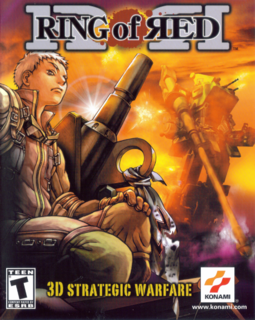A game whose premise is so unique that you´ll be hard press to find any other like it.
Those who will be first attracted to it will be the Turn-Based-Strategy fans. Ring of Red takes this tried and true formula and implements it flawlessly. The turn basis of the game is mixed, the order in which each unit moves depends on the complexity of its actions. Units that perform movement and attack will take longer to get back in action that those that only remain on `stand by´ status, this applies both for player and enemy units, resulting continuous flow of actions between the opposing forces. The second group of people that will feel attracted by this title will be the Mech fans, there is nothing as intimidating as a 30 foot tall lumbering war machine stepping into a battlefield, and the game perfectly portrays such illusion. And since Front Mission has gone MIA for so long outside of Japan, this title will be much appreciated. And the third group of people that this game appeals to is not a common one, not even within the SciFi community, the Alternative History fans. For Ring of Red is a game that takes place in a world where Japan did not surrender after the Atomic attacks on Hiroshima and Nagasaki. A Japan that was invaded by both Allied and Soviet forces creating a divided nation with different ideologies such as was Germany during the Cold War or as Korea is now. Therefore, the games´ Mechs are not futuristic Zone of the Enders affair, instead these are 1940-60´s tech inspired diesel engine behemoths. Once two units engage in battle the game switches to a real time 3D view of the robots and the supporting platoon that accompany the mechs; two squads on foot and one as crew support. It is within these confrontations where the game truly shines, showing both the nature of the combat mechanics and the true depth of the game. There is a limited amount of time within these battle sequences before your unit 'overheats' causing the end of the turn. Within said time limit the player must try to cause as much damage as possible to the enemy Mech, this can be accomplished via direct attacks using your mechs weapons or by issuing orders to your ground troops so as to attack the enemy robot or take measures to hinder its movements. It is at this level where the game displays the aspects of its dept: First, the aiming system within battles is an exciting and nerve wrecking experience all by itself; once you decide to attack the enemy with your main weapon, the view switches to a first person view of the enemy through a aiming reticle. The longer you keep the enemy within your crosshairs, the higher your accuracy rate will be. The higher the accuracy, the more damage your attack will make, but there is a catch, if you take too long before you fire, you´ll fire less times within the time limit and enemy might fire first, causing damage to your robot and messing up your aim. Fire too soon and your attack will not cause as much damage, or worse, miss altogether. This creates a fine balance between patience and restlessness in each confrontation. Second, the micromanagement of the kind of support soldiers that are embedded with your Mech may be the difference between victory or defeat. There are two kinds of soldier squads; anti-personnel soldiers: Infantry, Medics, and Recon, and anti-mech soldiers: Shooters, Suppliers and Engineers, each with its strengths and disadvantages. Depending on which three kind of soldiers you decide to assign to each Mech, its stats will vary both within battle as in the terrain grid. Each soldier type has special attacks and agilities uniques to its class, it is how you decide to use them in each battle the decisive advantage you may need to take down your enemy within a single turn, or for the enemy to totally overwhelm you.
Finally, there are the CO s /pilots of each mech, that much in the same fashion as in Advance Wars, have special 'powers' or abilities that can be used at particular moments during a face-off to increase the damage to the enemy or to defend yourself. As you increase your experience throughout the game, the number of times these Specials can be used. The Mechs, or as they are known in the Ring of Red universe, Armored Fighting Walkers (AFWs for short) are divided in four basic types: Standard AFWs (balanced, mid range attack), Light AFWs: (fast, short range anti personnel unit), 4 Legged AFWs (heavy, long range artillery) and Anti-AFWs (close quarter combat AFW killers).
It is the combination of all these factors that make this game so unique, deep and enjoyable. Don´t be fooled by it´s humble graphics, although its textures and polygon models look primitive, even by PS2 standards, everything animates extremely well and the sounds support the presentation diligently.
A must have for all Mech and Strategy game fans out there.

